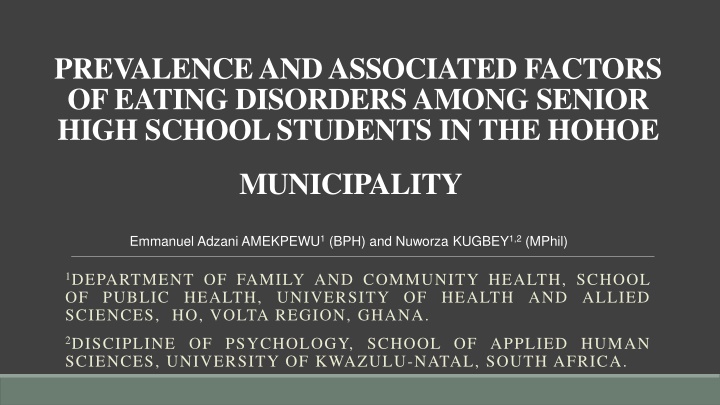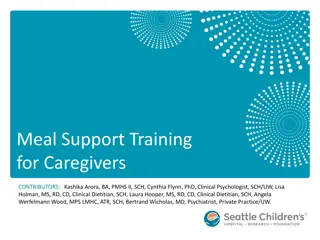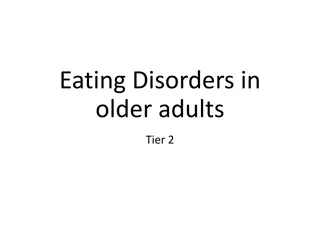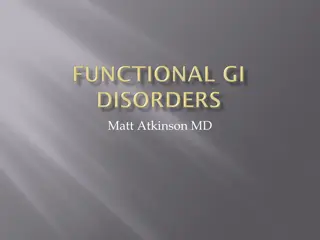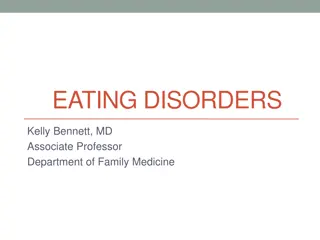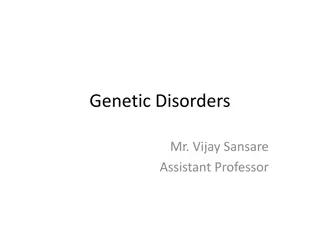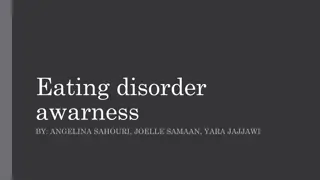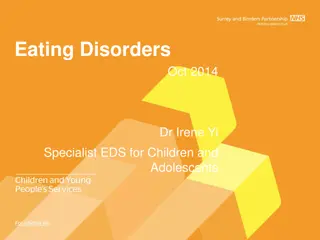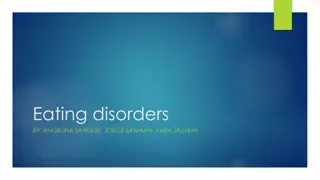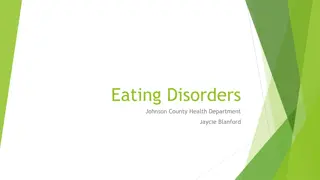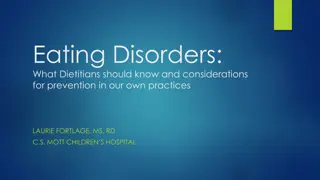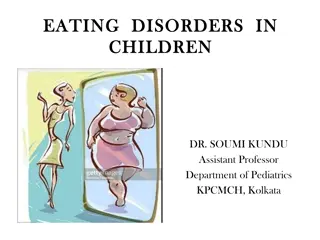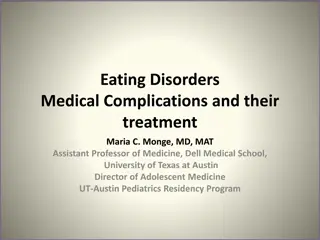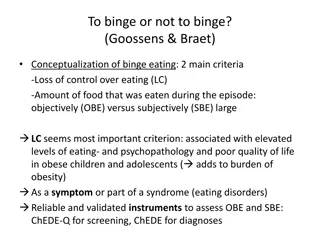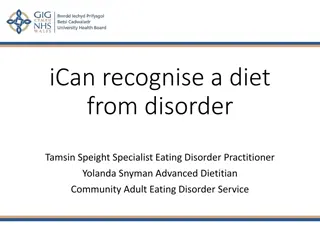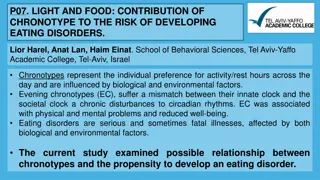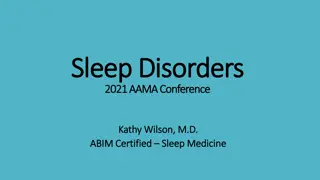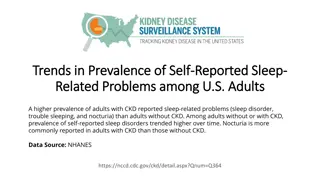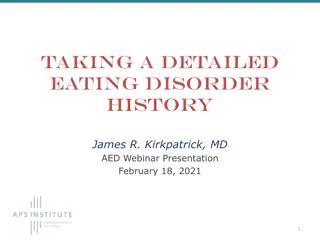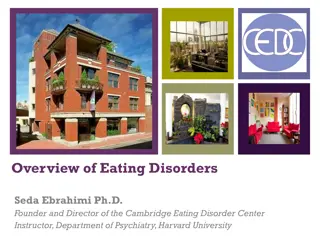Prevalence and Factors of Eating Disorders Among High School Students
Eating disorders pose serious risks to individuals, influenced by various factors such as genetics, trauma, and sociocultural ideals. The disorders, including anorexia nervosa and bulimia nervosa, have high mortality rates and often coexist with other mental conditions. Recognizing signs like body image concerns and food avoidance is crucial in adolescence where onset is common.
Uploaded on Sep 14, 2024 | 2 Views
Download Presentation

Please find below an Image/Link to download the presentation.
The content on the website is provided AS IS for your information and personal use only. It may not be sold, licensed, or shared on other websites without obtaining consent from the author.If you encounter any issues during the download, it is possible that the publisher has removed the file from their server.
You are allowed to download the files provided on this website for personal or commercial use, subject to the condition that they are used lawfully. All files are the property of their respective owners.
The content on the website is provided AS IS for your information and personal use only. It may not be sold, licensed, or shared on other websites without obtaining consent from the author.
E N D
Presentation Transcript
PREVALENCE AND ASSOCIATED FACTORS OF EATING DISORDERS AMONG SENIOR HIGH SCHOOL STUDENTS IN THE HOHOE MUNICIPALITY Emmanuel Adzani AMEKPEWU1 (BPH) and Nuworza KUGBEY1,2 (MPhil) 1DEPARTMENT OF FAMILY AND COMMUNITY HEALTH, SCHOOL OF PUBLIC HEALTH, UNIVERSITY OF SCIENCES, HO, VOLTA REGION, GHANA. HEALTH AND ALLIED 2DISCIPLINE OF PSYCHOLOGY, SCHOOL OF APPLIED HUMAN SCIENCES, UNIVERSITY OF KWAZULU-NATAL, SOUTH AFRICA.
Table of content Background Objectives Methods Results Discussion Conclusion Recommendation References
Background Eating disorders are abnormal eating habits that put the health and life of an individual at risk. According to the Center for Eating Disorders [CED] (2015), biopsychosocial factors such as genetics, biology, trauma, sociocultural ideals, dieting, and the family contribute highly to the development of eating disorders.
Background cont. The American Psychological Association [APA] (2017), revealed that eating disorders have the highest mortality rate of any mental illness. Four main types of eating disorders have been identified; anorexia nervosa, bulimia nervosa, binge eating, and unspecified eating disorder (APA, 2017)
Background cont. Individuals with eating disorders may present with signs like anxiety about eating certain foods, preoccupation with body shape and size, avoidance of situations that may involve food, excessive exercise, cutting out foods that was previously enjoyed, and social isolation (Beezley, 2016).
Background cont. Again, individuals with eating disorders experience higher rates of other mental disorders with reports indicating that up to 97% of these people are having a comorbid condition (National Collaboration [NEDC], 2012). Eating Disorder The National Eating Disorder Collaboration (2012), also reported that the onset of anorexia occurs most commonly during adolescence or young adulthood.
Background cont. Although a lot of papers have been published on eating disorders in other parts of the world, only a few known papers have been published in Ghana and Africa as a whole with focus on adolescents. It is therefore imperative to identified the proportion of senior high school students who are affected by eating disorders and some possible risk factors that were associated with eating disorders.
Objectives To estimate the proportion of students with eating disorders in the Hohoe municipality. To identify which gender groups of students are mostly affected with eating disorders in the municipality. To ascertain the relationship between eating disorders, depression and anxiety disorders. To examine risk factors associated with eating disorders.
Method The study was conducted in the Hohoe Evangelical Presbyterian Senior High School [HEPSS] within the Hohoe Municipality of the Volta Region. The study population consisted of both males and females students in the School who were 14 years and above. A descriptive cross-sectional survey was conducted among the senior high school students.
Method cont. A simple random sampling technique was employed in this study to select one school out of 10 Senior High Schools in the Hohoe municipality. The sample size for this study was 307.
Method cont. The questionnaire used to collect data comprised of the Eating Attitude Test-26 [EAT-26], Depression, Anxiety and Stress Scale [DASS] (only depression and anxiety sections were used), and self-designed questionnaire on demographics and risk factors of eating disorders.
Method cont. Generated data was analyzed with the use of the Statistical Package for Social Sciences (SPSS) software, version 22. Ethical approval for this study was sought from the Ghana Health Service Ethical review committee.
Limitations Data was not collected from Form three (3) students since they had completed school at the time of the data collection process. Also, only one senior high school was selected due to resource constraints.
Results A total number of 307 students data was used in this study, with 46.3% (142) males and 53.7% (165) females. The highest and the lowest age of respondents were 26 and 15 years which produced a mean age of the 17.8 .
Results cont. The prevalence of eating disorders identified among the 307 students was 46.9% (144). This also indicated a 22.5% (69) prevalence of eating disorders within students in SHS one and a 24.4% (75) prevalence of eating disorder within students in SHS two respectively.
Results cont. Eating disorder distribution among gender and age groups Variable Eating Disorder n (%) NO YES Gender Male 79 (48.5%) 63 (43.8%) Female 84 (51.5%) 81 (56.2%) Age group in years 15-19 150 (92.0%) 124 (86.1%) 20-24 13 (8.0%) 18 (12.5%) 25-25 0 (0%) 2 (1.4%)
Results cont. Out of the 144 students with eating disorders, 68.1% (98) of them were depressed and 71.5% (103) were anxious. The chi-square test of independence indicated that, depressed students 68.1% were significantly more likely to develop eating disorder as compared to non-depressed students 31.9% ( (1) = 9.93, p = 0.002). Anxiety disorder recorded no significant relationship between eating disorder among the students ( (1) = 3.54, p = 0.06).
Results cont. In examining some factors associated to eating disorders, a significant association was found between eating disorder and a student s family history of eating disorder, with students who reported having a family history of eating disorders, 60.4% (29) were more likely to be affected with eating disorder than their counterparts who reported having no family history of eating disorder, 44.4% (115) all within the students identified to be suffering from eating disorders ( (1) = 4.171, p = 0.041).
Results cont. 56.5% (74) of students with eating disorders changed their eating habit due to television shows on body size as compared to 39.8% (70) of students with eating disorder who did not change their eating habit due to television shows on body size ( (1) = 8.426, p = 0.004).
Results cont. There was no statistical significant link between eating disorder and these factors; peer influence to change body shape ( (1) = 0.57, p = 0.45), family member s influence to modify body form ( (1) = 2.393, p = 0.122), students who have been abused ( (1) = 0.158, p = 0.691), students who have ever used illicit substances ( (1) = 1.25, p = 0.263), students having a family member suffering from mental illness ( (1) = 2.613, p = 0.106).
Discussion The results of previous studies are inconsistent with prevalence of eating disorder (46.9%) identified in this study. For instance, Solmi (2014), identified 21.3% of the general population in United Kingdom and Finland to be affected with eating disorder. Consistent with other previous studies, females (49.1%) were more affected with eating problems than males (44.4%). Nishizawa et al. (2003) found 2.4% males and 11.2% females of high school students to have eating disorders.
Discussion cont. There was a significant association between depression and eating disorder in the results of this study. Similarly, Ulfvebrand, Birgeg rd, Norring, H gdahl and Hausswolff-Juhlin (2015) found a significant association depression and anorexia nervosa; bulimia nervosa; and binge eating disorder among females. between major
Discussion cont. The findings of this study reported no significant link between eating disorder and anxiety disorder. On the contrary, previous studies have identified a significant link between eating disorder and anxiety disorder. For instance, the prevalence rate of anxiety disorder among bulimia nervosa and binge eating disorder patients has been estimated to be between 60 -70% (Swanson, 2011).
Conclusion This study produced a high prevalence of eating disorders of 46.9% among students in the Hohoe municipality which is inconsistent with other previous studies among the general population. Also, the proportion of female students affected by eating disorders was greater than that of males which is similar to other studies.
Conclusion cont. Moreover, students who reported having a family history of eating disorders were more likely to be affected by eating disorders as compared to those who reported having no family history of eating disorders. Majority of the students affected by eating disorders were also largely influenced by television shows on modelling and body ideals.
Recommendation An intense education is needed to create the awareness of students on the negative impacts of eating disorders on their health. Also, a well-functioning mental health unit should be set up in senior high schools to assist students with eating disorders.
REFERENCES REFERENCES American Psychiatric Association. (2013). Diagnostic and statistical manual of mental disorders (DSM-5). American Psychiatric Pub. American Psychiatric Association. (2017). Eating disorders. Retrieved February 5, 2017, from http://www.apa.org/topics/eating/index.aspx Beezley, R. (2016). Nutrition students and eating disorders: Are you at risk? Retrieved March 21, 2017, from perspectives, http://thenutritionpress.com/nutrition-students-and-eating- disorders/ Center for Eating Disorders. (2015). Underlying causes of eating disorders. Retrieved February 13, 2017, from https://www.eatingdisorder.org/eating-disorder-information/Underlying-causes/ National Eating Disorder Collaboration. (2012). An Integrated Response to Complexity National Eating Disorders Framework. Nishizawa Y, Kida K, Nishizawa K, Hashiba S, Saito K, Mita R. (2003). Perception of self physique and eating behavior of high school students in Japan. Psychiatry Clin Neurosci, 57, 189-196. Swanson, S.V. (2011). Prevalence and Correlates of Eating Diso ders in Adolescents. Arch Gen Psychiatry 2011; 68:714-723.
